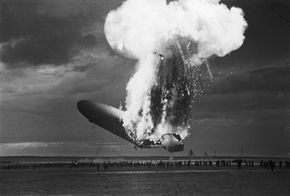Just how dangerous is it?
Now that you know about the dangers of hydrogen as a fuel source, should you be terrified by the prospect of having a tank full of it in your car? Not necessarily. Because hydrogen gas is so light, it disperses rapidly, mixing with the surrounding air and rapidly rising through it. Although pure hydrogen ignites quite easily, in reality, this diluted hydrogen mixture is no more likely to catch fire than gasoline is. And because it rises it isn't likely to remain near the ground, where it's most likely to harm people.
The most famous hydrogen fire in history was probably the explosion of the German airship Hindenburg in 1937. No one is exactly sure how the fire started -- there are a few theories -- but the Hindenburg contained a large quantity of hydrogen, which burst into flame along with the airship's skin. Of the 97 passengers and crewmembers on board the Hindenburg, 35 died. This harmed the reputation of hydrogen for many decades and most likely slowed its use as a fuel; however, there's no evidence that any of the victims were killed by the hydrogen fire itself. Most died when they panicked and jumped out of the airship. The rest were killed when the fire spread to the engines, as result of the airship's burning skin. The hydrogen, meanwhile, rose above the passengers and crewmembers, keeping the hydrogen fire above the mayhem happening below.
Advertisement
Because a hydrogen fire doesn't radiate as much heat as most fires do, it is less likely to cause secondary fires. This doesn't mean that the hydrogen fire wouldn't burn you if you touched it -- it's still plenty hot -- but it's less likely to spread. As for the hydrogen being odorless and undetectable, this can be offset to some extent by the addition of odorants to hydrogen fuel, giving the hydrogen an artificial yet detectable smell. As the hydrogen disperses the odorant won't necessarily travel with it, but you'll be able to determine that a hydrogen leak has occurred and take appropriate action.
As for the danger of asphyxiation -- this is really only a problem in an enclosed space, such as a garage. If a hydrogen leak occurs in the open, the rapid dispersal of hydrogen means that it's unlikely that there will be a large enough concentration of the gas to present a breathing hazard.
This doesn't mean that hydrogen shouldn't be treated with a healthy respect for its dangers, but in practice, these dangers are unlikely to be any greater than those of gasoline. In fact, with its rapid dispersal and tendency to rise, hydrogen could pose less of a threat than the fuels we use now.
For more information about hydrogen, fuel cells and other related topics, follow the links below.
Related HowStuffWorks Articles
More Great Links
Sources
- Gizmag. "Honda set to release hydrogen fuel cell car - and home fuelling station." (Aug. 22, 2008) http://www.gizmag.com/honda-fuel-cell-fcx/8394/
- Friedemann, Alice. "The Hydrogen Economy - Energy and Economic Black Hole." Culture Change. Sept. 2004. (Aug. 22, 2008) http://www.culturechange.org/alt_energy.htm
- U.S. Department of Energy. "Hydrogen, Fuel Cells and Infrastructure Technologies Program: Safety, Codes and Standards." Jan. 17, 2007. (Aug. 22, 2008) http://www1.eere.energy.gov/hydrogenandfuelcells/codes/
- U.S. Department of Energy. "Hydrogen Safety." Nov. 1, 2006. (Aug. 22, 2008) http://www1.eere.energy.gov/hydrogenandfuelcells/pdfs/doe_h2_safety.pdf
- U.S. Department of Energy. "Hydrogen and Our Energy Future." Sept. 4, 2007. (Aug. 22, 2008) http://www1.eere.energy.gov/hydrogenandfuelcells/pdfs/hydrogenenergy future_web.pdf
- U.S. Department of Energy. "Hydrogen Safety for First Responders." (Aug. 22, 2008) http://www.hydrogen.energy.gov/firstresponders.html
